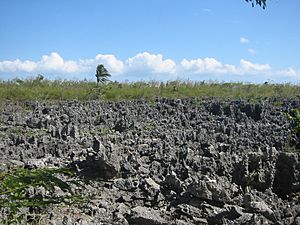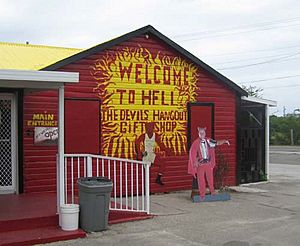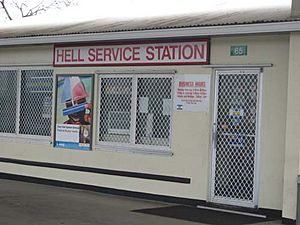Hell, Grand Cayman facts for kids
Hell is a very interesting spot located on Grand Cayman island in the Cayman Islands. It's a small area filled with short, black, jagged rocks made of limestone. You can find it in a part of the island called West Bay. The whole area is about half the size of a football field. While visitors can't walk directly on these unique rock formations, there are special viewing platforms where you can see them up close.
How Hell Got Its Name
There are a few stories about how this place got its unusual name, "Hell." Most of these stories are similar. They often say that someone, maybe a minister, looked at the strange, dark rocks and exclaimed, "This is what Hell must look like!"
Another story suggests the name came from the sound a small pebble makes. If you throw a pebble into the rock formations, it echoes. People say it sounds like the pebble is falling all the way down to "Hell."
No matter which story is true, the name "Hell" stuck! This unique spot has become a popular place for tourists to visit. You can even find a bright red post office there, shaped like a fire engine. From this post office, you can send postcards to your friends and family that say "postcards from hell." There's also a gift shop where a friendly person named Ivan Farrington, sometimes called "Satan," greets visitors with fun phrases like "How the hell are you?" and "Where the hell are you from?"
You might notice some shops in the area have quotes from the Bible on their walls. This shows how important religion is to the people of the Cayman Islands.
What Are Hell's Rocks Made Of?
The rocks at Hell are very special. They are jagged, spongy, and covered in a black layer. These unique shapes are formed when tiny living things, like algae, interact with the limestone rock.
Think of it like this: these tiny algae bore into the limestone. This process slowly dissolves the rock, creating the rough, spiky shapes you see. The black color comes from these tiny organisms that live just below the surface of the rock.
These rocks are a type of "biokarst." This means they are shaped by living organisms, not just by rain or wind. The black, sponge-like texture with its sharp points is very distinct. If you were to break off a piece, you'd see the black color is mostly on the outside, fading to gray inside.
It's believed that being close to the ocean is important for these formations. The spray and mist from the waves might provide just enough moisture for the algae to thrive. So, when you visit other rocky coastlines in the Caribbean, especially those made of limestone, you might see similar formations! Hell on Grand Cayman is just the most famous example of this amazing natural process.




